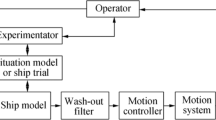Abstract
Sprint canoe paddling is a dynamic and complicated motion performed with the entire body of the paddler. Not only the upper limb motion, but also the motions of the trunk and lower limbs contribute to the propulsion. The objectives of this study were to simulate sprint canoe paddling, and investigate the contributions of the upper and lower limbs, and the trunk, to the propulsion during paddling. In the model, the paddler, paddle, and hull were represented as three rigid bodies, which were connected by virtual springs and dampers. The geometry of the paddler, paddle, and hull, as well as the joint motion of a paddler, was used in the model. It was found that the model could predict instantaneous hull velocity variation, although the average hull velocity was 8% lower than experiment. Two virtual paddling motions, “fixed lower limbs” and “fixed trunk,” were simulated. Comparing the measured original and the two virtual paddling motions, it was found that the lower limb motion during paddling contributed to the propulsion during the catch phase, when the blade entered the water until fully submerged (ratio of the contribution: 14% by upper limbs, 63% by lower limbs and 23% by trunk). It was also found that the upper limb motion contributed to the propulsion during the draw phase, when the paddler pulled the paddle backwards relative to the hull (54% by upper limbs, 30% by lower limbs and 16% by trunk), and that the trunk motion contributed to the propulsion just prior to the paddle exiting the water (7% by upper limbs, 30% by lower limbs and 63% by trunk).










Similar content being viewed by others
References
Caplan N (2008) A simulation of outrigger canoe paddling performance. In: Estivalet M, Brisson P (eds), The engineering of sport 7, vol 1. Springer, Paris, pp 97–105
Caplan N (2009) The influence of paddle orientation on boat velocity in canoeing. Int J Sports Sci Eng 3(3):131–139
Morgoch D, Tullis S (2011) Force analysis of a sprint canoe blade. J Sports Eng Tech 225(4):253–258
Morgoch D, Galipeau C, Tullis S (2016) Sprint canoe hydrodynamics—modeling and on-water measurement. Procedia Engineering 147. In:Proceedings of the 11th conference of the International Sports Engineering Association, ISEA 2016. pp 299–304
Nakashima M, Yamazaki S, Yue J, Nakagaki K (2014) Simulation analysis of paddling motions in a single kayak: development of a comprehensive dynamic model of a paddler, paddle and hull. J Sports Eng Tech 228(4):259–269
Nakashima M, Kitazawa A, Nakagaki K, Onoto N (2016) Simulation to clarify the effect of paddling motion on the hull behavior of a single kayak in a sprint race. Sports Eng 20(2):133–139
Nakashima M, Satou K, Miura Y (2007) Development of swimming human simulation model considering rigid body dynamics and unsteady fluid force for whole body. J Fluid Sci Tech 2(1):56–67
Nakashima M (2007) Mechanical study of standard six beat front crawl swimming by using swimming human simulation model. J Fluid Sci Tech 2(1):290–301
Nakashima M (2009) Simulation analysis of the effect of trunk undulation on swimming performance in underwater dolphin kick of human. J Biomech Sci Eng 4(1):94–104
Nakashima M (2010) Modeling and simulation of human swimming. J Aero Aqua Bio Mech 1(1):11–17
Nakashima M, Kiuchi H, Nakajima K (2010) Multi agent/object simulation in human swimming. J Biomech Sci Eng 5(4):380–387
Nakashima M. Suzuki S, Nakajima K (2010) Development of a simulation model for monofin swimming. J Biomech Sci Eng 5(4):408–420
Kiuchi H, Nakashima M, Cheng KB, Hubbard M (2010) Modeling fluid forces in the dive start of competitive swimming. J Biomech Sci Eng 5(4):314–328
Nakashima M, Maeda S, Miwa T, Ichikawa H (2012) Optimizing simulation of the arm stroke in crawl swimming considering muscle strength characteristics of athlete swimmers. J Biomech Sci Eng 7(2):102–117
Nakashima M, Ono A (2014) Maximum joint torque dependency of the crawl swimming with optimized arm stroke. J Biomech Sci Eng 9(1):1–9
Nakashima M, Suzuki S, Ono A, Nakamura T (2013) Development of the transfemoral prosthesis for swimming focused on ankle joint motion. J Biomech Sci Eng 8(1):79–93
Nakashima M, Ono A, Nakamura T (2015) Effect of knee joint motion for the transfemoral prosthesis in swimming. J Biomech Sci Eng 10(3):15–00375
Nakashima M, Hatakeyama G, Homma M, Ito K (2013) Simulation analysis of lift in synchronized swimming. J Aero Aqua Bio Mech 3(1):51–56
Nakashima M, Nakayama Y, Minami Y, Takagi H (2014) Development of the simulation model for throwing motion in water polo. Sports Eng 17(1):45–53
Nakashima M, Minami Y, Takagi H (2015) Optimizing simulation for lower limb motion during throwing in water polo. Mech Eng J 2(4):472
Author information
Authors and Affiliations
Corresponding author
Ethics declarations
Conflict of interest
The authors declare that they have no conflicts of interest.
Rights and permissions
About this article
Cite this article
Nakashima, M., Ito, S. & Nakagaki, K. Simulation of sprint canoe paddling. Sports Eng 22, 1 (2019). https://doi.org/10.1007/s12283-019-0297-2
Published:
DOI: https://doi.org/10.1007/s12283-019-0297-2




